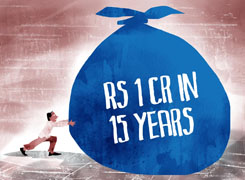Ramalingam Kalirajan |10874 Answers |Ask -Follow
Mutual Funds, Financial Planning Expert - Answered on Jun 18, 2024
He has an MBA in finance from the University of Madras and is a certified financial planner.
He is the director and chief financial planner at Holistic Investment, a Chennai-based firm that offers financial planning and wealth management advice.... more

Hi , I am 44 yrs old and having working wife and two son of 17 yrs & 5 yrs... elder son is down syndrom.. joint monthly take home is 2 lacs.. having 85 lacs of mutual fund.. 18 lacs in PPF, 32 lacs in EPF, & around 25 lacs in others like FD, saving, shares etc.. monthly saving around 1.2 lacs including 75K SIP, 18K PPF, 25K EPF etc... Having Own home at my native place.... Want to know that should I go for new Flat purchase at location where I am residing in rented house of monthly 14K excluding electricity or continue my investment in place of Home loan... I hv opted new tax slab and my wife is in old tax... my target to have 15 CR at the age of 60
Income and Savings
Your combined monthly take-home income is Rs. 2 lakhs. Your current savings include:
Mutual Funds: Rs. 85 lakhs
Public Provident Fund (PPF): Rs. 18 lakhs
Employees’ Provident Fund (EPF): Rs. 32 lakhs
Other Investments (FD, Savings, Shares): Rs. 25 lakhs
Your monthly savings distribution is as follows:
SIP in Mutual Funds: Rs. 75,000
PPF: Rs. 18,000
EPF: Rs. 25,000
You live in a rented house with a rent of Rs. 14,000 per month.
Evaluating the Decision to Buy a New Flat
Current Housing Situation
Living in a rented house at Rs. 14,000 per month is relatively affordable, especially given your high monthly income. Renting provides flexibility and lower maintenance costs compared to owning.
Financial Impact of Buying a New Flat
Purchasing a new flat would involve a significant financial commitment, including a home loan, maintenance costs, property taxes, and other associated expenses. This would reduce your investable surplus and potentially impact your ability to meet your financial goals.
Comparative Analysis: Rent vs. Buy
Renting: Offers flexibility, lower upfront costs, and avoids long-term debt.
Buying: Provides stability and potential appreciation in property value but requires a large financial commitment and ongoing expenses.
Long-term Financial Goals
Target: Rs. 15 Crores by Age 60
To achieve your target of Rs. 15 crores by age 60, you need to focus on maximizing your investments' growth while maintaining a balanced risk profile.
Current Investments and Growth Potential
Mutual Funds: Your Rs. 85 lakhs in mutual funds can grow substantially with continued SIPs and market performance.
PPF and EPF: These provide stable, long-term growth with tax benefits, contributing to your retirement corpus.
Other Investments: FDs, savings, and shares add diversification but should be reviewed for optimal growth potential.
Investment Strategy
Enhancing SIP Contributions
Continuing and potentially increasing your SIP contributions will leverage the power of compounding. Focus on a mix of equity and debt funds to balance growth and risk.
Recommendation: Consider increasing your SIP by a percentage each year to keep pace with inflation and maximize returns.
Diversification and Rebalancing
Ensure your portfolio is diversified across various asset classes to minimize risk and optimize returns. Periodically review and rebalance your portfolio to stay aligned with your financial goals.
Recommendation: Include large-cap, mid-cap, and multi-cap funds for equity exposure. Balance with debt funds for stability.
Utilising Tax-efficient Investments
Maximize your contributions to tax-efficient instruments like PPF and EPF. These not only provide stable returns but also offer significant tax benefits.
Recommendation: Continue maximizing your PPF contributions and ensure your EPF contributions are optimized.
Emergency Fund Management
Maintaining a robust emergency fund is crucial. Your current Rs. 25 lakhs in FD and savings can be used to cover unexpected expenses.
Recommendation: Keep at least 6-12 months of living expenses in easily accessible liquid assets.
Estate Planning and Insurance
Life and Health Insurance
Ensure adequate life and health insurance coverage for your family, especially considering your elder son's needs. This will protect your family's financial stability in case of unforeseen events.
Recommendation: Opt for a comprehensive health insurance plan and term insurance for sufficient coverage.
Estate Planning
Create a comprehensive estate plan, including a will, to ensure your assets are distributed according to your wishes and your family is taken care of.
Recommendation: Consult a legal expert to draft a will and set up any necessary trusts.
Education and Future Planning for Children
Special Needs Planning
Given your elder son's Down syndrome, consider creating a financial plan that ensures his long-term care and support.
Recommendation: Look into setting up a special needs trust and explore government schemes and benefits available for children with disabilities.
Education Fund for Younger Son
Start a dedicated investment plan for your younger son's education. This can include child-specific mutual funds or education-focused investment plans.
Recommendation: Allocate a portion of your monthly savings towards an education fund.
Final Insights
Given your strong financial position and disciplined saving habits, you are well on your way to achieving your long-term goals. However, buying a new flat at this stage might not be the best financial decision if it significantly impacts your investment capacity.
Focusing on growing your investment portfolio and maintaining a balanced, diversified approach will help you accumulate the desired Rs. 15 crores by age 60. Ensuring adequate insurance coverage and planning for your elder son's special needs will further secure your family's future.
Stay disciplined with your investments, periodically review your portfolio, and make adjustments as needed to stay on track. Consulting with a Certified Financial Planner can provide personalized advice and help optimize your financial strategy.
Best Regards,
K. Ramalingam, MBA, CFP,
Chief Financial Planner,
www.holisticinvestment.in
You may like to see similar questions and answers below
Ramalingam Kalirajan |10874 Answers |Ask -Follow
Mutual Funds, Financial Planning Expert - Answered on Oct 23, 2024
Ramalingam Kalirajan |10874 Answers |Ask -Follow
Mutual Funds, Financial Planning Expert - Answered on Jan 06, 2025
Ramalingam Kalirajan |10874 Answers |Ask -Follow
Mutual Funds, Financial Planning Expert - Answered on Dec 16, 2024
Ramalingam Kalirajan |10874 Answers |Ask -Follow
Mutual Funds, Financial Planning Expert - Answered on May 24, 2025
Reetika Sharma |417 Answers |Ask -Follow
Financial Planner, MF and Insurance Expert - Answered on Sep 19, 2025
Mayank Chandel |2569 Answers |Ask -Follow
IIT-JEE, NEET-UG, SAT, CLAT, CA, CS Exam Expert - Answered on Dec 08, 2025
Mayank Chandel |2569 Answers |Ask -Follow
IIT-JEE, NEET-UG, SAT, CLAT, CA, CS Exam Expert - Answered on Dec 08, 2025

Mayank Chandel |2569 Answers |Ask -Follow
IIT-JEE, NEET-UG, SAT, CLAT, CA, CS Exam Expert - Answered on Dec 08, 2025
Mayank Chandel |2569 Answers |Ask -Follow
IIT-JEE, NEET-UG, SAT, CLAT, CA, CS Exam Expert - Answered on Dec 08, 2025
Mayank Chandel |2569 Answers |Ask -Follow
IIT-JEE, NEET-UG, SAT, CLAT, CA, CS Exam Expert - Answered on Dec 08, 2025
Anu Krishna |1746 Answers |Ask -Follow
Relationships Expert, Mind Coach - Answered on Dec 08, 2025
Ramalingam Kalirajan |10874 Answers |Ask -Follow
Mutual Funds, Financial Planning Expert - Answered on Dec 08, 2025
Samraat Jadhav |2499 Answers |Ask -Follow
Stock Market Expert - Answered on Dec 08, 2025
Ramalingam Kalirajan |10874 Answers |Ask -Follow
Mutual Funds, Financial Planning Expert - Answered on Dec 08, 2025
Radheshyam Zanwar |6737 Answers |Ask -Follow
MHT-CET, IIT-JEE, NEET-UG Expert - Answered on Dec 08, 2025
























